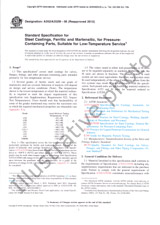We need your consent to use the individual data so that you can see information about your interests, among other things. Click "OK" to give your consent.
ASTM C743-87(2018)
Standard Test Method for Continuity of Porcelain Enamel Coatings
Translate name
STANDARD published on 1.10.2018
The information about the standard:
Designation standards: ASTM C743-87(2018)
Note: WITHDRAWN
Publication date standards: 1.10.2018
SKU: NS-903314
The number of pages: 4
Approximate weight : 12 g (0.03 lbs)
Country: American technical standard
Category: Technical standards ASTM
The category - similar standards:
Annotation of standard text ASTM C743-87(2018) :
Keywords:
continuity, glass coating, high voltage test, light coverage, porcelain enamel, porcelain enamel thickness,, ICS Number Code 25.220.50 (Enamels)
Additional information
| 1. Scope | ||||
|
1.1 Porcelain enamel coatings are applied to metals to provide protection from corrosion as well as to enhance their appearance. This test method permits the easy detection of discontinuities and areas of light coverage, not readily seen by visual inspection, which limit the protection to the substrate. Somewhat similar tests applicable to the thicker glass coatings used for chemical reaction vessels are found in Test Methods C536 and C537. 1.2 Values stated in SI units are to be regarded as the standard. Inch-pound units are provided for information only. 1.3 This standard does not purport to address all of the safety concerns, if any, associated with its use. It is the responsibility of the user of this standard to establish appropriate safety, health, and environmental practices and determine the applicability of regulatory limitations prior to use. 1.4 This international standard was developed in accordance with internationally recognized principles on standardization established in the Decision on Principles for the Development of International Standards, Guides and Recommendations issued by the World Trade Organization Technical Barriers to Trade (TBT) Committee. |
||||
| 2. Referenced Documents | ||||
|



 Cookies
Cookies
